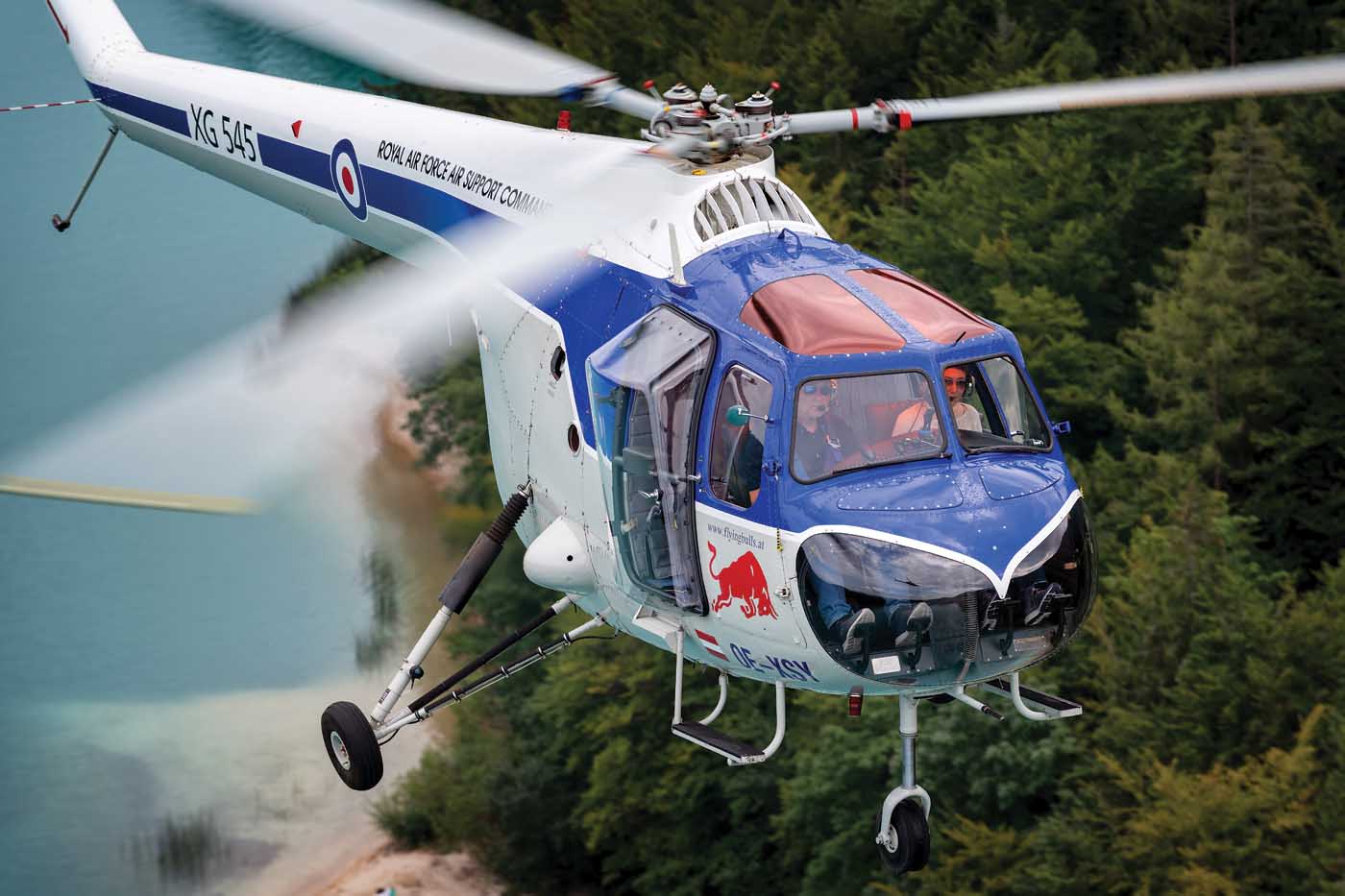Eighty years after Igor Sikorsky first flew his revolutionary VS-300, helicopter design is a relatively mature field. The industry has settled on a handful of configurations and design philosophies, and when you get behind the controls of a modern helicopter, you can usually be confident that it will handle like other modern helicopters, more or less.
The vintage helicopters that survived into the present era, like the Bell 47, tended to be the ones that pioneered those successful design philosophies. So it’s easy to forget that there was once much more diversity in helicopters, as their designers pursued ideas that sometimes led to dead ends. Back in those early days, no one was quite sure how helicopters would be used, let alone how to optimize them for their missions. And while everyone was trying to figure that out, even some relatively short-lived models played important roles in shaping the industry as we know it now.
The Bristol 171 Sycamore is one of those helicopters. To the modern eye, it looks more like a cartoon drawing of a helicopter than a functional rotorcraft, with a squat cabin, a three-bladed main rotor system that is nearly flush with the roof, and an absurdly long tail. Inside the cockpit, things are equally perplexing. Instead of a thumb switch on the cyclic for trim, the Sycamore has two massive trim wheels on a center console. It can be fitted with dual cyclic controls for two-pilot operations and flight instruction, but has only a single, centrally positioned collective, with a twist-grip throttle attached to the collective at a right angle. It also has a complicated system for transferring ballast fluid between tanks to maintain the center of gravity (CG) within limits — a feature that is simply unnecessary in modern designs.
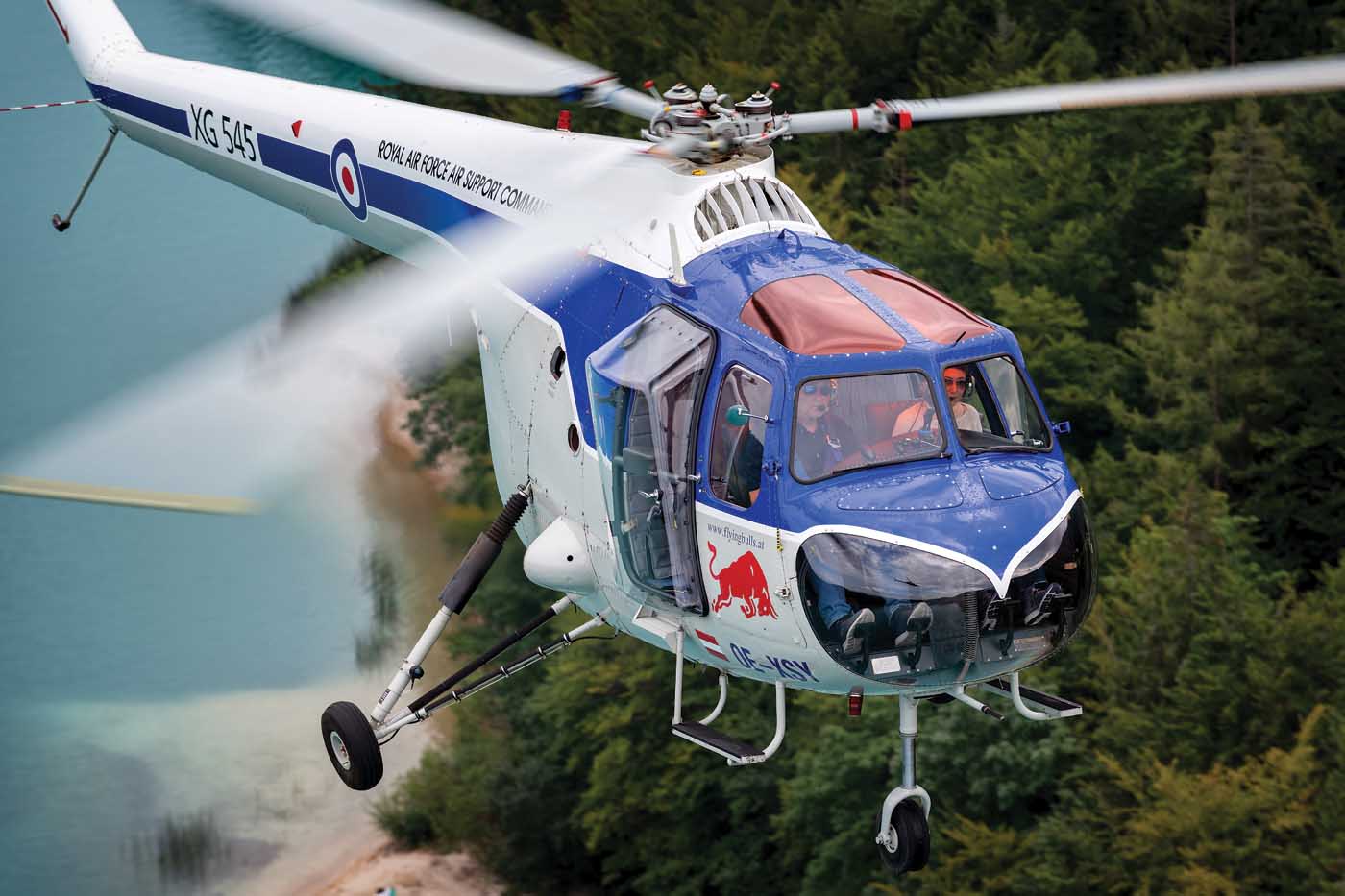
It’s not hard to understand why the Sycamore, which made its first flight in 1947 and ended production before 1960, quickly became obsolete. Today, it is largely forgotten. I had never heard of it until a few months before I made a pilgrimage to Salzburg, Austria, to fly the last airworthy Sycamore in the world, which is now the property of Red Bull’s flying display team, the Flying Bulls. And for most of his career, the only pilot currently licensed to fly the Sycamore — Flying Bulls chief rotary-wing pilot Siegfried “Blacky” Schwarz — didn’t give much thought to it, either.
“I never thought about the Sycamore, never did even know the helicopter,” Schwarz recalled. Then, about a dozen years ago, Schwarz was contacted by a German technician named Dieter Hasebrink, a specialist on the model. For decades, the Sycamore’s legacy had been zealously preserved by Swiss vineyard owner Peter Schmidt, who had collected multiple aircraft and an enormous cache of spare parts. Now, Hasebrink explained, Schmidt was getting older, and wanted to pass the torch. The Flying Bulls were already well known for their collection of lovingly restored vintage warbirds — would they be willing to add a Sycamore to their fleet, too?
Initially, Schwarz wasn’t too interested. But after meeting Hasebrink and seeing the Sycamore firsthand at AERO Friedrichshafen in Germany, Schwarz became increasingly captivated by this peculiar aircraft and its remarkable history. He finally recommended the purchase of Schmidt’s collection to his boss, Red Bull owner Dietrich Mateschitz, and the transfer was made in 2010. The Flying Bulls decided to focus their restoration efforts on one helicopter, now registered as OE-XSY, which had last flown in 2006. With Schwarz at the controls, it returned to the air in 2013.

“It’s really incredible [to] fly such a piece of aviation history,” said Schwarz, who is now one of the Sycamore’s biggest fans. “And if you think that maybe 40 years ago there was also some guy sitting in this helicopter and flying in the night in a storm out on the North Sea and doing some rescue.” Red Bull’s Sycamore is more than just a curiosity — it’s a flying reminder of the impact the model had both on individual lives and the course of aviation as a whole. As Schwarz put it, “every old helicopter can tell you a lot of stories.” Now Red Bull is making sure that the Sycamore’s stories aren’t forgotten.
A British original
Produced by the Bristol Aeroplane Company, the Sycamore was the first helicopter to be designed and certified in Great Britain, and was one of the first helicopters to be used by the Royal Air Force (RAF). The RAF paint scheme on the Red Bull helicopter — permission for which was obtained by Peter Schmidt from Queen Elizabeth herself — honors that legacy, although what is now OE-XSY was actually delivered in 1957 to Germany, which operated 50 of the model in search-and-rescue and other roles.
The Sycamore also has a connection to Austria through its designer, Raoul Hafner, an Austrian who moved to England between the World Wars. Hafner had already designed several experimental helicopters and gyroplanes by the mid-1940s, when he was appointed as Bristol’s chief helicopter designer and tasked with developing the Sycamore. The first of several prototypes performed its maiden flight in July 1947, powered by a 450-horsepower, nine-cylinder Pratt & Whitney R-985 Wasp Junior radial engine. This was replaced by a 550-hp Alvis Leonides radial engine on the version that was certified in 1949, and on the subsequent production model, the Sycamore Mk. 4.
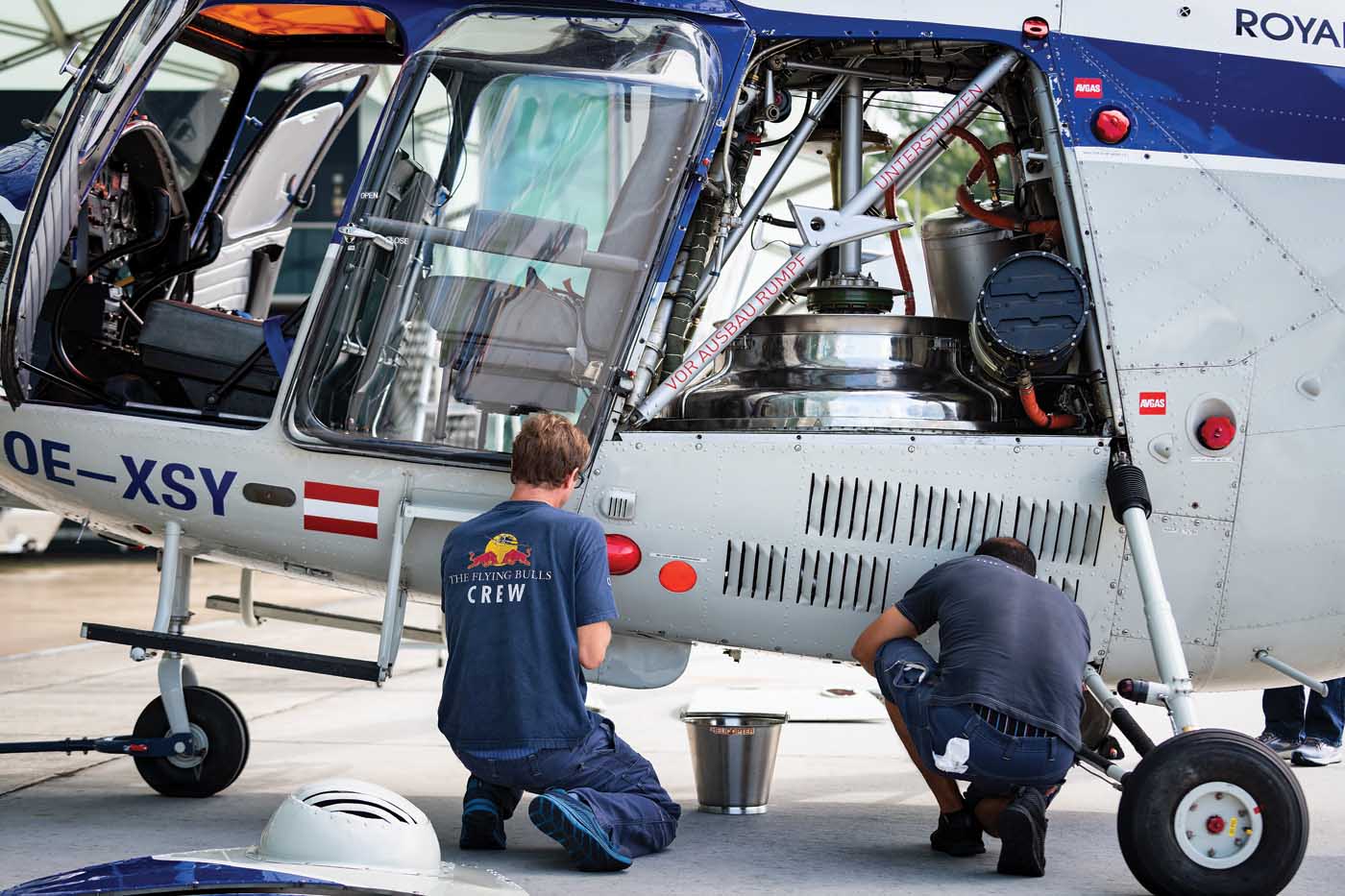
The five-seat Sycamore filled an immediate need for the RAF in the Federation of Malaya (now Malaysia), where the colonial British government was battling communist insurgents in the guerrilla war the British called the “Malayan Emergency.” As RAF Wing Commander John Dowling recounted in RAF Helicopters: The First 20 Years, a Sycamore was delivered to Singapore for initial operational trials in early 1953. Unfortunately, its wooden rotor blades deteriorated rapidly in the tropical climate, and the trials had to be postponed until a replacement set arrived. Although these fared much better, heat and humidity would continue to take their toll, ultimately resulting in two fatal accidents due to main rotor blade disintegration. Following the second of these in 1959, the RAF Sycamore fleet was temporarily grounded while the blade design was modified.
Despite this very considerable shortcoming, Dowling said the Sycamore acquired an “excellent reputation” in Malaya, where it replaced the underpowered Westland Dragonfly, a license-built version of the Sikorsky S-51. The Sycamore also shone in comparison to the larger Westland Whirlwinds — license-built versions of the S-55 — which at the time were still powered by Wasp radial engines. Not only did the Sycamore have much better serviceability rates, it also carried more payload in Malaya’s hot-and-high conditions, despite being a smaller aircraft.
In 1960, however, Westland equipped the Whirlwind with a turbine engine, and the aircraft leapfrogged ahead. The larger helicopter industry also shifted to turbines, and production of the Alvis Leonides ceased in 1966. Meanwhile, helicopter manufacturers also moved away from temperamental wooden blades in favor of metal and fiberglass ones — all of which meant that by the time Red Bull acquired its Sycamore, the manufacturing techniques used for both its engine and rotor blades were lost arts.

Helicopter maintenance supervisor Thomas Schörghofer joined the Flying Bulls in 2011, not long after the Sycamore did. He explained that when Red Bull’s maintenance team performed an initial inspection on the aircraft, they discovered a corroded cam ring on its Leonides engine. “So then we [made] the decision to remove the engine and to repair it, but it was not easy, because nobody [had] knowledge on this engine,” he said.
Eventually, the Flying Bulls connected with CFS Aero, an overhaul and repair facility in the U.K. Working with several spare engines that were included in Schmidt’s collection, CFS remanufactured an engine using the best parts from each. “But a big problem then arose — there was no test stand, so they [could] not run the engine in the U.K.,” Schörghofer continued.
So instead, CFS shipped the engine back to Salzburg, where the Flying Bulls installed it in the aircraft for ground runs. “And there [were] some minor problems, and [we had] to remove again the engine, repair it, reinstall it. So it was taking a lot of time to do that,” he said.
The Flying Bulls were also wary of the Sycamore’s wooden rotor blades, which were more than half a century old and impossible to inspect internally. Fortunately, there were enough spare blades in Schmidt’s collection that they were able to send some to the Graz University of Technology for destructive testing. According to Schwarz, the tests revealed that the precisely crafted blades were “in really good condition,” easily up to their original certification standards. The wooden blades may have suffered in tropical environments, but apparently they did just fine in temperate central Europe.

There was one final hurdle to flying the Sycamore: an operational rather than a technical challenge. Because there were no longer any authorized Sycamore instructors — no licensed Sycamore pilots at all, in fact — there was no one who could provide Schwarz with training on the model. In order to teach himself how to fly it, he was required to obtain a test pilot license from the European Union Aviation Safety Agency (EASA). Fortunately, if anyone was qualified for the task, it was Schwarz — a renowned flight instructor and champion helicopter aerobatics pilot with decades of experience under his belt.
Eventually, he had to establish an EASA-approved training
organization in order to sign himself off for his check flight. “Finally I could give myself the certification that because I was the head of training, I have trained myself,” he explained. “And with this letter, the authority could send me an examiner who [had] never seen the Bristol Sycamore before.” Today, Schwarz is still the only pilot licensed on the model, although he hopes to train another pilot in the not-too-distant future. Unfortunately, on the Sycamore, that’s not as simple as it sounds.
Made for cruising
To understand the Sycamore’s idiosyncrasies, it’s necessary to bear in mind that it was “a completely individual development by the Bristol Aeroplane Company, not derived from any previous production helicopter,” as John Dowling explained in his RAF history. As such, “it displayed characteristics which reflected specific personal convictions of its designer — Mr. Raoul Hafner.”
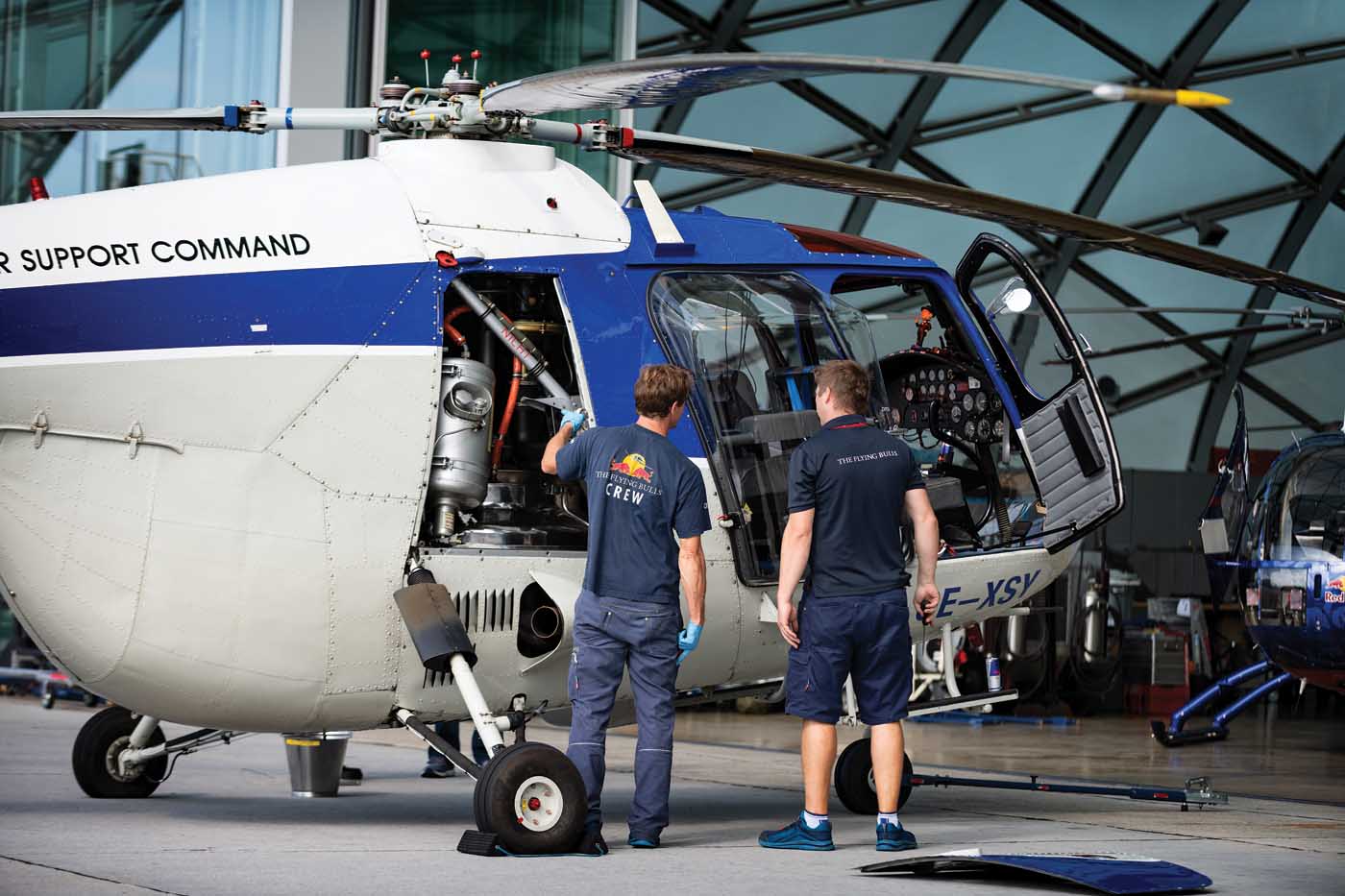
According to Dowling, Hafner wanted “a fast manually controlled helicopter which cruised and stood on the ground with the fuselage substantially level.” To achieve manual control without the need for hydraulic assistance, Hafner developed a “spider control” for the main rotor system in which metal tie bars carry blade centrifugal forces rather than the flapping hinges. In most helicopters, multiple control rods act on a swashplate near the rotor blades, but in the Sycamore, control inputs are transmitted through a single control rod to the “spider” assembly on the main rotor head, similar to the approach later used on Enstrom models.
In the late 1940s, helicopters were still a largely experimental technology, with many of their eventual uses yet to be discovered. It was not obvious to Hafner that some of their most valuable applications would involve prolonged hovering, so he chose to optimize the Sycamore for cruise flight “on the grounds that the helicopter spent only a minute fraction of its time in the takeoff and hover,” as Dowling put it. To achieve a level fuselage attitude and comfortable cyclic position in cruise flight — around 70 knots — Hafner tilted the Sycamore’s rotor head forward approximately five degrees. He also arranged the control system so that the cyclic was centered laterally as well as fore-and-aft in the cruise, rather than requiring the pilot to input increasing left cyclic with higher airspeeds (on the clockwise-turning main rotor system).
This means that in the hover, the pilot must hold the cyclic back and to the right to counter the Sycamore’s tendency to drift forward and left. Prior to takeoff, the pilot uses the trim wheels on the center console to tension the cyclic trim springs to the correct position for the hover. However, because the aircraft is transitioning from a nose-level attitude on the ground to a nose-high attitude in the hover, the pilot must pre-position the cyclic for takeoff against the pressure of the springs — and failure to do so correctly can have severe consequences.

Recalling the experiences of early RAF Sycamore pilots, Dowling wrote, “If the pilot failed to find the correct position, he was immediately made aware of an error in the fore-and-aft sense because he could see and correct any tendency for the aircraft to move forward or backwards. Insufficient right pressure on the stick was more difficult to detect because sideways motion was resisted by the non-castering main undercarriage wheels.” In such an instance, the type of slow, careful takeoff that is used to avoid dynamic rollover in skid-equipped helicopters could actually trigger it in the Sycamore, causing the aircraft to pivot over its left rear wheel and onto its left side. According to Dowling, “If the stick were correctly positioned before takeoff or if the ‘unstick’ was performed reasonably smartly, there was no danger. Both precautions were part of the basic technique.”
Decades later, when Schwarz was preparing for his own first flight in the model, he sought advice from former Sycamore pilots from the U.K., Germany, and New Zealand. They duly warned him about this peculiarity, but Schwarz might have taken their warnings too much to heart.
“The only thing they could remember was when you lift off, you have to pull the cyclic full to the right,” Schwarz told me. When the time came for his momentous first takeoff, with cameras rolling and the fire brigade standing by, “I pulled on the collective and in my mind I still had to keep the cyclic to the right. [But] you have no idea because you have no hydraulic assistance — you need a lot of force on the controls and it’s not reacting like a normal helicopter.” In his attempt to avoid rolling to the left, Schwarz actually pulled the cyclic too far to the right, causing the helicopter to bounce off its right rear wheel, then its tail skid, before he regained control.

“It was quite an exciting time!” he said. “But finally after three or five seconds where everybody was afraid, I got the [feeling for it]. And then it was a pretty stable hover and our test program [started with] five hours just hovering around.”
Like Schwarz, most of the early Sycamore pilots quickly got the hang of the heavy controls. “Of much more concern,” according to Dowling, was the shared central collective lever in the production Sycamore. Early prototypes had the pilot sitting on the left, in keeping with fixed-wing aircraft, but in the production model the pilot was moved to the right seat, enabling the comparatively free left hand to manipulate switches and radios. Rather than adding a removable collective lever to the left-hand side for training and two-pilot operations — as became standard practice in the helicopter industry — the Sycamore made do with a single shared collective, with a twist-grip throttle mounted at a right angle for use by either pilot.
“This regrettable aberration produced the most serious and only really thoroughly objectionable feature of the Sycamore,” Dowling wrote, blaming the eccentric design for numerous incidents and accidents, “as well as extending the instructor’s course on the aircraft by at least 10 hours for each pilot (i.e. 30 percent), and often more. . . .
“The fact was that only the helicopter pilots who had tried it knew how difficult it was to change hands on the controls, and how frequently the aircraft would very nearly crash while attempting to maneuver near the hover or in transitions to the hover while flown from the left seat.” According to Dowling, by the time the consequences of this “unfortunate error” became apparent to the Sycamore’s operators, it was too late to reverse it.
Flying back in time
I wasn’t fully up to speed on this history when I had a chance to fly Red Bull’s Sycamore in August of this year. But I certainly knew enough about the aircraft to recognize what an enormous privilege it was to even sit in it, let alone touch the controls. Of course, I also realized that flying the last airworthy example of any aircraft type is a particularly high-consequence endeavor, since even minor damage can’t necessarily be easily repaired. So I was happy to follow Schwarz’s lead and fly as much, or as little, as he saw fit.
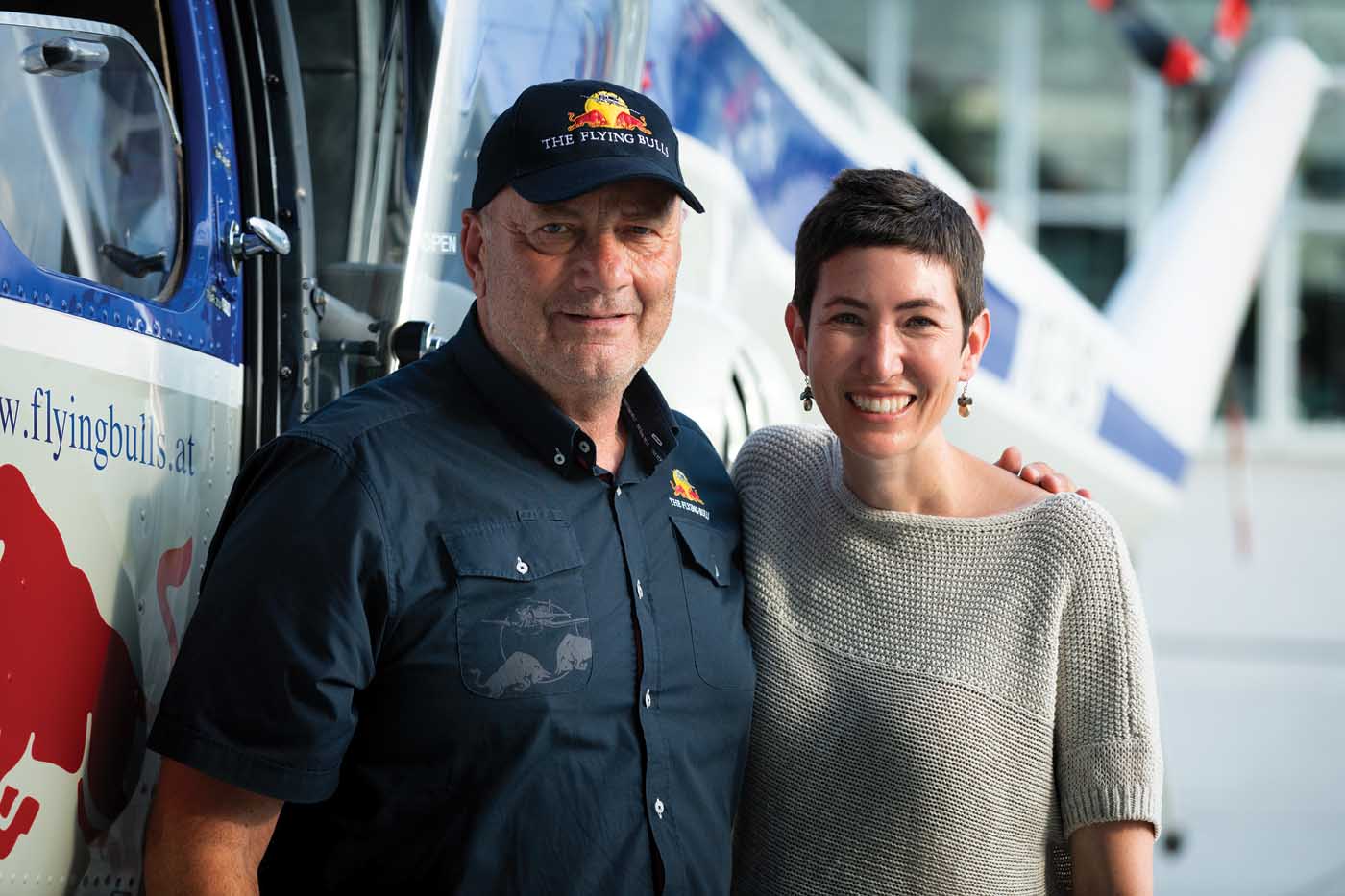
From the left seat, I followed along as Schwarz went through a relatively straightforward piston engine start and run-up sequence in front of Red Bull’s legendary Hangar-7 at the Salzburg airport. When we were ready to depart, Schwarz ground-taxied us away from the hangar, then carried the momentum through a rolling liftoff into a hover taxi. Cleared for takeoff by the tower along with an accompanying Red Bull camera ship — an Airbus AS350 — we didn’t linger long over the runway. As soon as we were up and away, Schwarz made a couple of adjustments to the trim wheels, then turned control of the cyclic and pedals over to me. He retained control of the collective and throttle because of their strange configuration, and he also managed the CG compensating system, which was utterly unfamiliar to me.
I quickly realized that there wasn’t much to my job, since the Sycamore does indeed fly very comfortably in cruise flight. Although I was initially wary of those huge trim wheels, it didn’t take me long to get the feel for them (granted, not having to simultaneously manage the collective and throttle undoubtedly helped). It wasn’t until the end of our flight, when I was flying an approach back to the airport and Schwarz set the trim wheels for the hover, that I really had to work at it. Arriving in the hover felt a bit like flying an AS350 with the hydraulics off; I wasn’t prepared for it, and Schwarz resumed control before I embarrassed myself.
According to Schwarz, these transitions are the most difficult part of performing in air shows with the Sycamore. “During hover or if you change speed, it takes an incredible amount of force because you have not the time to change the trim wheels, especially if you fly a display,” he said. “So you are covered with sweat. . . . You just have to do it with brutal force to force the helicopter to do what you want.”

Thanks to Peter Schmidt’s passion for the model and his diligence in collecting spare parts, the Red Bull Sycamore has unusually good prospects for an aircraft of its age and rarity. According to Schwarz, “it was many full truckloads [of parts] that we brought from Switzerland to Austria” — encompassing everything from critical items like rotor blades and gearboxes, to such minor fixtures as position lights. “I guess I have 140 red position lights and 120 green position lights,” Schwarz pointed out.
With luck, the Sycamore will continue flying for many more years to come, educating and inspiring air show audiences and visitors to Hangar-7. And, in the process, providing unique insight into how the helicopter industry got started, and how it evolved.





